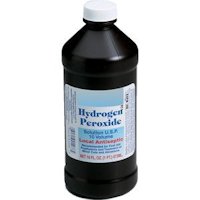
|
Some Common Myths Thought to be True - Myth 63
Myth 63: Hydrogen Peroxide is a Good Disinfectant or Antiseptic
Hydrogen peroxide is used as a 6% solution to clean and deodorize
wounds and ulcers. More commonly, 3% solutions of hydrogen peroxide have been
used in household first aid for scrapes, etc. However, even this less potent
form is no longer recommended for typical wound care, as the strong oxidization
causes scar formation and increases healing time. Gentle washing with mild
soap and water or rinsing a scrape with sterile saline is a better
practice.
|
| Hydrogen Peroxide | |
|
The application of peroxide on wounds produces an effervescent bubbling that
makes it look like the wound is being thoroughly cleansed. Researchers who
discourage the use of peroxide as a wound treatment do not deny that peroxide
kills dirt and bacteria. A major disadvantage of peroxide is that the solution
is so abrasive - even when diluted with water - that the natural healing
process that takes place within the skin cells is halted following application.
The damage that peroxide does to the skin might manifest with dryness, itching
and discoloration around and inside the wound. Wounds that have been treated
with peroxide typically take longer to heal than wounds that have been treated
with soap and water, and a wound that is open longer has a greater risk of
infection.
|
|
| ⇦ Back to Myth 62 Return to Myth Choices Page 5 On to Myth 64 ⇨ | |